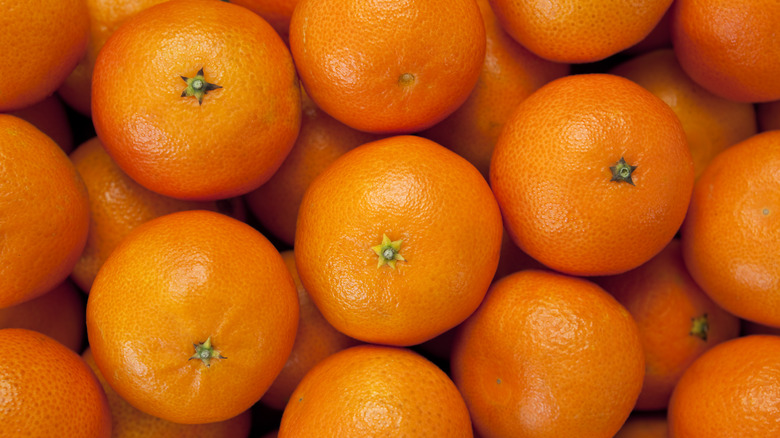Substitute Tangerine For Your Usual Lemon Chicken
If you're cooking up a classic roast chicken and don't have any lemons on hand, or you just want to shake things up a little bit, consider the tangerine. It's an easy-as-pie switch to make. Slice them in half and put them in the chicken cavity, just as you would with lemons. There are some flavor differences to expect: You'll lose some of the sour-bitter notes of lemon and get a slightly sweet, tangy kick instead. However, this change doesn't just work for roast chicken. You can sub tangerine into any other chicken recipe that calls for lemon, like Greek chicken with orzo, on a one-to-one basis. These recipes may call for zest or juice (rather than full fruit), and luckily, tangerine zest and juice fit right into a myriad of recipes.
Since tangerines have notably more sugar than lemons, you'll want to be wary of adding extra sugar (or any other sweet ingredients) into your chicken recipe if you're making this change. Some stewy or saucy lemon chicken recipes might call for a little brown sugar. Play it safe and drop this completely if you're using tangerines, so your chicken dinner doesn't accidentally become chicken dessert. If you think the dish ultimately needs the sugar, you can just add it at the end. If you're stuffing the fruit into a roast chicken and your recipe also calls for a glaze, you'll probably still want to use sugar, since this ingredient is necessary to brown the skin and form a light glaze.
What to know about tangerines
Replacing lemon with tangerine in a chicken recipe is more of a twist than a direct substitute, since these two citrus fruits have fairly different flavor profiles. So, if your goal is to get a flavor as close to lemon as possible, subbing in tangerine might not be your best choice (you'd be better off going for lime, or perhaps an orange, if you can find a relatively bitter one).
Tangerines are related to oranges, and there aren't many differences between tangerines and clementines, either. However, tangerines are usually smaller and more tart than oranges, which makes them better suited to stuffing into a roast chicken cavity. They break up neatly into segments, similar to mandarins; and have a notably higher acidity than oranges, but lower than lemons. (So, adding splash of vinegar to a tangerine chicken could bridge that gap if you think you need lemon-level acidity.)
Additionally, tangerines are much sweeter than lemons — so when you're shopping, you'll want to look for ones that have a little softness to them (without being squishy) and a robust orange color, if you need a ripe one. There are a few different varieties of tangerine out there, but most of them have few to no seeds, and they're usually in season around late fall into winter.
What else works with tangerine
Although they're a little less commonly used, tangerines can be as versatile as lemons, and there aren't really any firm rules about where they can and can't be used in cooking. Tangerines work in cocktails and desserts, where they can also take the place of lemons (just don't forget to account for the added sweetness). They work in plenty of savory dishes beyond chicken — seafood, pork, and beef are great pairings for tangerine, too. Some recipes, like this tangerine beef with glass noodles, suggest using the tangerine juice to make a broth or a sauce.
It's noteworthy that tangerines are sometimes seen as a more festive fruit compared to some of their citrus counterparts. This is largely because they come into season around Christmastime. So, you could use that as a starting point for pairing other ingredients with them. For example, other festive flavors like cinnamon might work with both sweet or savory recipes. Given the fruit's east Asian origins, they also pair well with flavors like ginger, soy sauce, and garlic. Not only could you incorporate these flavors into a tangerine chicken recipe, but also into the sides you serve with it, such as green beans with garlic and soy sauce to go with that tangy chicken.


